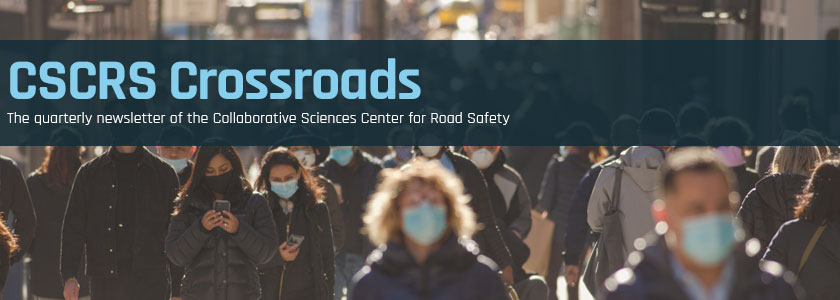CSCRS selects 12 new transportation safety research projects
This spring, CSCRS selected 12 new research projects to explore a range of transportation safety topics and extend its ongoing research activities. This is CSCRS’s fourth round of research projects selected through a peer-review process. The 12 new projects:
- U.S. Regional Vision Zero Implementation (led by Kelly Evenson, UNC Injury Prevention Research Center (IPRC))
- COVID-19 streets: Mobility justice and the rapid rollout of pedestrian and bicyclist improvements (led by Tabitha Combs, UNC Department of City and Regional Planning (DCRP))
- Using Safe Systems approach to assess traffic impact and land development (led by Tabitha Combs, DCRP)
- Laying the Groundwork for a National Pedestrian Injury Surveillance System (led by Katherine Harmon, UNC Highway Safety Research Center (HSRC))
- Applying AcciMap to e-Scooter Crashes: A Safe Systems approach to analyzing micromobility (led by Michael Clamann, HSRC)
- Assessing how private beliefs conflict with public action on Safe Systems (led by Seth LaJeunesse, HSRC)
- Integrating systems thinking tools into Vision Zero and Safe Systems approaches (led by Becky Naumann, IPRC)
- A Safe Systems approach to motorcycle safety (led by Eric Dumbaugh, Florida Atlantic University (FAU))
- Bike-sharing as a safety intervention: Evidence from nine large US cities (led by Eric Dumbaugh, FAU)
- Advancing crash investigation with connected and automated vehicle data – Phase 2 (led by Michael Clamann, HSRC)
- Applying AI to data sources to improve driver-pedestrian interactions at intersections (led by Subhadeep Chakraborty, University of Tennessee, Knoxville (UTK))
- Safety enhancement by detecting driver impairment through analysis of real-time volatilities (led by Asad Khattak, UTK)
To learn more about all CSCRS research projects and activities, visit roadsafety.unc.edu/research.
NaTMEC 2021 connects the traffic monitoring world with Safe Systems concepts
The CSCRS-hosted National Travel Monitoring Exposition and Conference (NaTMEC) 2021, June 21-25, 2021, will focus on the role traffic monitoring plays in ensuring a safe transportation system. Several of the 40+ sessions during this virtual event will be presented by CSCRS researchers sharing recent work:
- “Rating Datasets for the National Pedestrian and Bicycle Safety Data Clearinghouse”
Speaker: Krista Nordback, HSRC - “Systemic, Risk-based Pedestrian Safety Process”
Speaker: Wes Kumfer, Ph.D, RSP1, HSRC
- “Walking with biosensing wristbands: An exploration of pedestrian stress in natural and urban environments”
Speaker: Seth LaJeunesse, HSRC - “Use of Performance Measures to Improve Data Quality”
Speaker: Nancy Lefler, HSRC
Browse the NaTMEC website for registration, the full agenda, and other helpful information. Sponsorship opportunities are still available; the Sponsors page includes a list of sponsors, sponsor packages, and a thorough FAQ section. Contact Jennifer Palcher-Silliman directly for more information.
Next CSCRS webinar examines how traffic crashes are framed on TV
The next CSCRS webinar, “Traffic Crashes as Seen On TV: An Opportunity to Reshape the Dialogue Around Road User Injury,” will be held on July 1, 2021, 2 – 3 PM Eastern. CSCRS researchers Seth LaJeunesse, HSRC, and Sydney Nicolla, UNC Hussman School of Journalism and Media, will share insight from their CSCRS project Factors and frames that shape public discourse around road user safety, which involved analyzing more than 1,000 U.S. TV news stories featuring crashes between 2012-2019. The webinar will focus on their findings, which revealed clear patterns of reporting, such as focusing on traffic congestion, placing responsibility solely on road users, and treating most crashes as isolated from other crashes. This project has produced a media framing guide for transportation and public health professionals.
CSCRS bookshelf: Student projects address equity issues in transportation

Alejo Alvarado
In this edition of CSCRS bookshelf, instead of sharing reading recommendations for others’ work, we’re pleased to share the work of two CSCRS students, both of whom focused their final graduate school projects on topics related to equity issues in transportation. Check out their impressive reports:

Sarah Brown
- Alejo Alvarado, MCRP, University of California, Berkeley, Safe Transportation Research and Education Center, “The Racial Equity Implications of Road Safety Enforcement in Oakland, CA”
- Sarah Brown, MCRP, DCRP, “Evaluating the Framing of Safety, Equity, and Policing: Responses to the Murder of George Floyd, Black Lives Matter, and Calls to Defund the Police”
2020 CSCRS Student of the Year, Benjamin Bauchwitz

Benjamin Bauchwitz
In January 2021, CSCRS announced Benjamin Bauchwitz, a doctoral student in the Humans and Autonomy Lab (HAL) at Duke University, as its 2020 Outstanding Student of the Year. Bauchwitz was honored during the Council of University Transportation Center’s virtual 2021 Awards Banquet. CSCRS chose Bauchwitz as its outstanding student as part of a U.S. Department of Transportation program honoring students from University Transportation Centers who have demonstrated achievements in academic performance, research, leadership, professionalism, and potential future contributions in the transportation field.
Systems spotlight: New resources
CSCRS continues to see results from the valuable conversations had and connections made at the Safe Systems Summit in 2019. And we’re so happy to be a part of many efforts to share information and resources further exploring the Safe Systems topic. (It’s “tech transfer” at work!) Two new resources – developed by others – to share:
Webinar: CSCRS to participate in NTSB Safe System virtual roundtable
On Thursday, May 20, CSCRS researchers and other partners will participate in the National Transportation Safety Board (NTSB) roundtable “A Safe System Approach to Traffic Safety.” The goal of the event, to be held 12 – 2 PM Eastern, is to increase awareness of the Safe System approach and elevate it as a proven effective strategy to eliminate deaths and serious injuries in motor vehicle crashes. The event site includes a link to join the roundtable. NTSB invites participants to submit questions in advance to NTSBSafeSystemRoundtable@ntsb.gov.
Stay tuned! NTSB is planning additional future events that will explore the Safe System approach.
Resource: Recommendations of the Safe System Consortium now available
CSCRS leadership, Advisory Board members, and researchers were pleased to join a group of engineers, scientists, public health professionals, and safety experts convened by the Johns Hopkins Center for Injury Research & Policy and the Institute of Transportation Engineers in early 2021 to discuss the potential for reimagining road safety and equity in the United States.
A series of productive conversations and deliberations resulted in Recommendations of the Safe System Consortium, designed to provide recommendations “to change the course of road safety and work toward a more equitable transportation system.”
As the recommendations state, “frustrated that conventional safety approaches have not shifted the rank of traffic deaths as the leading cause of death for young people and with the associated endemic inequities rooted in our road transportation system, the group considered the potential of the Safe System approach for changing the way roads affect our lives and communities.”
Also, read CSCRS Advisory Board member and Vison Zero Network Founder and Director Leah Shahum’s related blog post, “Addressing Safety & Equity with the Safe System Approach.”
Education and professional development: Review
CSCRS continues to engage students and professionals in a variety of other learning activities:
- The North Carolina Department of Transportation (NCDOT) is accepting presentation abstracts for the third annual/second virtual NCDOT Research & Innovation Summit, October 2021. Abstracts are due June 9, 2021.
- The NC Vision Zero Leadership Team Training Institute, to be held in June 2021, will train multidisciplinary teams from eight North Carolina cities on core Vision Zero principles and coalition building best practices. The trainings integrate research findings from CSCRS projects including Strengthening existing and facilitating new Vision Zero plans.
- CSCRS will be launching a virtual Safe Systems summer learning series this summer. The series will cover such topics as redefining safety and change management tools for Safe System implementation. More details will be announced soon.
- CSCRS researchers presented and/or participated in approximately 105 lectern and poster sessions, panel discussions, and committee meetings as part of the virtual 2021 Transportation Research Board (TRB) Annual Meeting.
- A video produced by Duke that highlights how Duke and UNC team up on science featured Duke’s Missy Cummings and Benjamin Bauchwitz, as well as CSCRS Director Laura Sandt:
Other CSCRS highlights
A quick rundown of additional recent activities related to CSCRS and its partners:
- This Science Direct article, co-written by Laura Sandt, offers a research roadmap covering equity, active travel, transit, and more to inspire new collaborative thinking connecting transportation and public health: “Advancing research in transportation and public health: A selection of twenty project ideas from a U.S. research roadmap.”
- Chris Cherry, UTK, co-authored the article “Comparison of motor vehicle-involved e-scooter and bicycle crashes using standardized crash typology,” for the Journal of Safety Research.
- Eric Dumbaugh, FAU, wrote “Worst Practices: How Urban Planning Fails Vision Zero,” an opinion article on the relationship between urban planning and Vision Zero efforts for the Vision Zero Cities Conference that was reprinted in Streetsblog.
- A National Safety Council report from March 2021 estimated that as many as 42,060 people in the U.S. died in motor vehicle crashes in 2020.
For more on CSCRS’s activities from the last several months, view the most recent Semi-Annual Progress Report.
Join CSCRS on social media
Like our Facebook page and follow us on Twitter.
Sign up to receive CSCRS news and updates.
CSCRS Crossroads newsletters are archived here.






